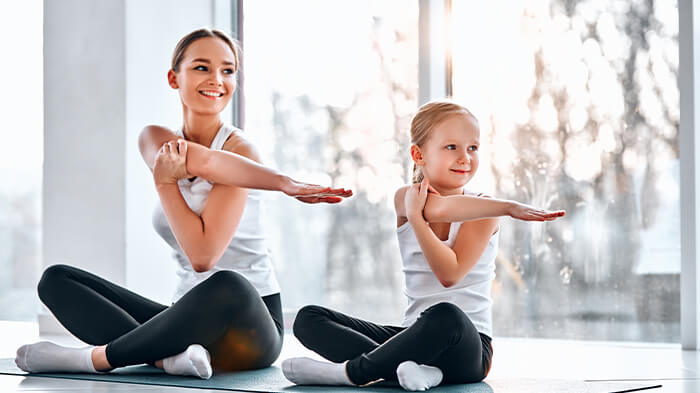Stretching exercises are essential components of any fitness routine, serving multiple purposes such as enhancing flexibility, preventing injury, and improving overall mobility. Engaging in a regular stretching regimen not only promotes physical well-being but also helps to clear the mind, allowing for a more holistic approach to health. A daily stretching routine can be incredibly beneficial, offering both short-term relief and long-term gains in flexibility and mobility.
Stretching exercises

The world of stretching exercises is vast and diverse, with countless techniques designed to improve the body’s flexibility and range of motion. These exercises can be categorized into various types: static, dynamic, passive, and active stretches. Understanding these categories is vital to creating a balanced routine that meets your individual needs.
The Importance of Stretching
Stretching serves numerous functions within the realm of physical fitness. First and foremost, it prepares the body for physical activity by increasing blood flow to muscles and connective tissues, which enhances performance and reduces the risk of injuries. Furthermore, stretching aids in the recovery process post-exercise, alleviating muscle tightness and soreness.
Many athletes and fitness enthusiasts have reported significant improvements in their performance levels due to consistent stretching routines. For instance, dancers often rely on rigorous stretching to attain the fluidity and grace required for their art. Similarly, runners incorporate stretching to maintain their agility and prevent injuries associated with tight muscles or poor flexibility.
Stretching isn’t solely for athletes; it’s beneficial for everyone. Regularly engaging in stretching exercises can lead to improvements in posture, balance, and even mental clarity. As you stretch, your body releases endorphins, which can boost mood and contribute to a sense of well-being.
Types of Stretching Exercises
In exploring stretching exercises, it’s crucial to understand the different types available.
- Static Stretching involves holding a position for an extended period, typically 15 to 60 seconds. This method is particularly effective for improving flexibility.
- Dynamic Stretching consists of controlled movements that gently take you to the limits of your range of motion. It’s excellent for warming up before physical activity.
- Passive Stretching requires assistance from an external force, such as a partner or prop, to help achieve a deeper stretch.
- Active Stretching involves engaging specific muscles to stretch opposing muscle groups, fostering strength and flexibility simultaneously.
Understanding these types of stretches allows you to design a comprehensive routine tailored to your goals, whether you’re aiming to improve athletic performance or simply maintain overall wellness.
Creating a Daily Stretching Routine
Establishing a daily stretching routine necessitates careful consideration of your goals, physical condition, and time availability. Ideally, your routine should cover all major muscle groups, including the neck, shoulders, back, hips, legs, and arms.
Start with a warm-up to prepare your muscles for stretching. This can involve light aerobic activities such as brisk walking or gentle jogging. Once warmed up, you can transition into a series of stretches targeting each muscle group.
Make sure to listen to your body and avoid pushing yourself into painful positions. Stretching should feel good, releasing tension rather than causing discomfort. Over time, you’ll notice increased flexibility and improved mobility, allowing you to engage in a broader range of activities.
Best stretches for better flexibility and mobility
When it comes to achieving better flexibility and mobility, some stretches stand out as particularly effective. These best stretches for better flexibility and mobility not only enhance your physical abilities but also contribute to a healthier lifestyle overall. Here we will explore several key stretches along with tips on how to perform them correctly.
Hamstring Stretch
The hamstrings are a group of muscles located at the back of your thighs, playing a crucial role in many physical activities. Tight hamstrings can limit your flexibility and lead to lower back pain.
To perform a basic hamstring stretch, sit on the floor with one leg extended straight while the other leg is bent, foot against your inner thigh. Reach towards your toes on the extended leg, keeping your back straight. Hold this position for 15 to 30 seconds, breathing deeply.
This stretch not only improves the elasticity of the hamstrings but also encourages blood flow to the area, supporting recovery and reducing the risk of strains during workouts. Incorporating this stretch into your daily routine can yield noticeable improvements over time.
Hip Flexor Stretch
Hip flexors are essential for movement and stability, yet they often become tight due to prolonged sitting or inactivity. A tight hip flexor can affect your posture and lead to discomfort in the lower back.
To stretch your hip flexors effectively, begin in a lunge position with one foot forward and the other knee resting on the ground. Gently push your hips forward and hold for 15 to 30 seconds. You should feel a stretch in the front of your hip on the side with the knee down.
Adding this stretch to your routine can enhance mobility in your hips, making activities like squatting, running, and climbing stairs easier and more comfortable. Regular practice will allow your hips to move more freely, contributing to better overall coordination.
Shoulder Stretch
The shoulders are involved in nearly every upper-body movement, making shoulder flexibility paramount for maintaining an active lifestyle. A common issue is the tendency for shoulder muscles to tighten, especially among those who work at desks for extended periods.
To stretch your shoulders, stand tall and extend one arm across your chest. Grab the arm with your opposite hand and gently pull it closer, feeling the stretch across your shoulder. Hold for 15 to 30 seconds before switching sides.
Incorporating shoulder stretches into your routine can alleviate tension and improve range of motion, allowing for safer and more efficient upper-body movements. As you progress, you may find that you can achieve greater flexibility and ease in everyday tasks.
Cat-Cow Stretch
The Cat-Cow stretch is a dynamic stretch that targets the spine while also engaging the core and promoting optimal flexibility. It is particularly useful for warming up the back and relieving tension accumulated throughout the day.
Begin on all fours with your hands directly under your shoulders and knees under your hips. Inhale as you arch your back (the ‘Cow’ position) and lift your head and tailbone towards the ceiling. Exhale, rounding your spine upwards (the ‘Cat’ position), tucking your chin and pelvis. Continue moving between these two positions in a smooth, flowing motion.
Performing the Cat-Cow stretch regularly can significantly improve spinal flexibility and reduce discomfort in the back. Additionally, it promotes mindfulness and relaxation through controlled breath and movement.
Conclusion
Incorporating a daily stretching routine filled with thoughtful stretching exercises is an invaluable practice for anyone seeking improved flexibility and mobility. By understanding the importance of stretching and engaging in the best stretches for better flexibility and mobility, individuals can pave the way for a healthier, more active lifestyle. Remember to listen to your body, be patient with your progress, and commit to consistency. Ultimately, the rewards of increased flexibility go beyond physical benefits, enriching your overall quality of life.


